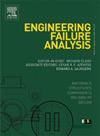Formation and development of surface fold defects in heavy-duty rails
IF 4.4
2区 工程技术
Q1 ENGINEERING, MECHANICAL
引用次数: 0
Abstract
This study explored the formation and propagation of longitudinal cracks in the webs of in-service rails. Based on the mechanical property testing, hardness measurements, and microstructural analyses, the cracks were identified as originating from a rolling-induced defect known as“folding”. The formation mechanism of the folding defect and its contribution crack propagation were further analyzed through corrosion resistance experiments and stress analysis simulations. The results indicated that microcracks and shrinkage porosity within the metal oxide film at the folding site exposed the underlying metal to the external environment. Under cyclic fatigue loading during rail operation, this exposure accelerated the crack growth from the folding defect. The associated safety risk is closely linked to the rail stress state: fold defects located on the outer surface (non-load-bearing) side of the web are less critical than those on the inner surface (load-bearing) side. As rail wear progressed, the stress concentrations increased by a factor of 1in straight sections and more than threefold in curved sections, which substantially posed the risk of failure under repeated loading and a significant threat to railway operational safety.
重载钢轨表面褶皱缺陷的形成与发展
本文研究了在役钢轨腹板纵向裂纹的形成与扩展。根据机械性能测试、硬度测量和显微组织分析,确定裂纹是由轧制引起的“折叠”缺陷引起的。通过耐蚀试验和应力分析模拟,进一步分析了折叠缺陷的形成机理及其对裂纹扩展的贡献。结果表明,金属氧化膜在折叠部位的微裂纹和缩孔使金属暴露在外部环境中。在钢轨运行过程中,在循环疲劳载荷作用下,这种暴露加速了由褶皱缺陷引起的裂纹扩展。相关的安全风险与钢轨应力状态密切相关:腹板外表面(非承重)侧的褶皱缺陷比内表面(承重)侧的褶皱缺陷更为严重。随着钢轨磨损的加剧,直线段的应力集中增加了1倍,弯曲段的应力集中增加了3倍以上,这大大增加了在重复载荷下失效的风险,对铁路运营安全构成了重大威胁。
本文章由计算机程序翻译,如有差异,请以英文原文为准。
求助全文
约1分钟内获得全文
求助全文
来源期刊

Engineering Failure Analysis
工程技术-材料科学:表征与测试
CiteScore
7.70
自引率
20.00%
发文量
956
审稿时长
47 days
期刊介绍:
Engineering Failure Analysis publishes research papers describing the analysis of engineering failures and related studies.
Papers relating to the structure, properties and behaviour of engineering materials are encouraged, particularly those which also involve the detailed application of materials parameters to problems in engineering structures, components and design. In addition to the area of materials engineering, the interacting fields of mechanical, manufacturing, aeronautical, civil, chemical, corrosion and design engineering are considered relevant. Activity should be directed at analysing engineering failures and carrying out research to help reduce the incidences of failures and to extend the operating horizons of engineering materials.
Emphasis is placed on the mechanical properties of materials and their behaviour when influenced by structure, process and environment. Metallic, polymeric, ceramic and natural materials are all included and the application of these materials to real engineering situations should be emphasised. The use of a case-study based approach is also encouraged.
Engineering Failure Analysis provides essential reference material and critical feedback into the design process thereby contributing to the prevention of engineering failures in the future. All submissions will be subject to peer review from leading experts in the field.
 求助内容:
求助内容: 应助结果提醒方式:
应助结果提醒方式:


